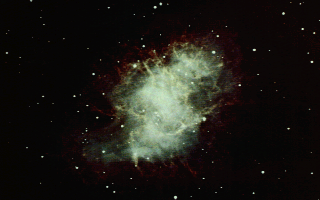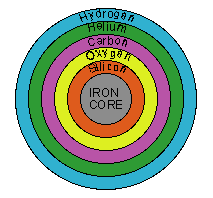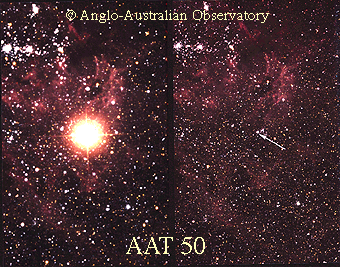
Astronomy 162: Professor Barbara Ryden

In the absence of effective pressure support, the iron core collapses in less than a second. When the core reaches the density of an atomic nucleus (an amazing 400 million tons per cubic centimeter), it resists further compression and bounces back. The rebounding core sends a shock wave through the outer layers of the star, heating them up. (The heating process is helped by neutrinos, a few of which are actually absorbed at these high densities, and by turbulent convection.)
The shock-heated gas starts to expand outward at high speed (roughly 5 percent the speed of light, at first). Thus, the implosion (or rapid collapse) of the core ultimately triggers the explosion (or rapid outflow) of the star's outer layers. This explosion is what astronomers call a supernova. [The word ``nova'' is Latin for ``new''. When a star explodes, its luminosity shoots up, and may cause a previously invisible star to look like a ``new star'' (or ``nova stella'') in the sky. As long as I'm giving a Latin lesson, I should note that the plural of ``supernova'' is ``supernovae''.]
Supernovae are rare, luminous, and relatively brief events.
Flash forward: when modern astronomers turn their telescopes to the position of the guest star, they see the Crab Nebula (pictured below):

The Crab Nebula is located 2000 parsecs (6500 light years) from Earth, and is 1.5 parsecs (5 light years) in radius. It consists of an expanding filamentary shell of gas. The currently measured expansion velocity of 1500 km/second is sufficient to have carried the shell outward by 1.5 parsecs in the past 949 years, since the ``guest star'' was first noted.
Plausible hypothesis: What the Chinese astronomers saw 949 years ago was a giant explosion. What we see today is the expanding debris from that explosion.
Making elements heavier than iron is difficult because it requires the addition of energy. (Going from wood to ashes is easy, because burning wood releases energy; going from ashes to wood is difficult, because it requires the addition of energy.) In fact, it seems that the high-energy shockwaves in supernovae are the only places in the universe where heavy elements are made in bulk. Thus, gold, lead, silver, copper, uranium, and other heavy elements are forged in supernova explosions, and spread by expanding supernova remnants throughout the galaxy.
Supernova remnants, you will recall, also play a major role in star formation, by triggering the collapse of dark nebulae. As they expand outward, supernova remnants empty out huge low-density ``bubbles'' in the interstellar medium. We appear to be inside such a bubble, 100 parsecs across, carved out by a supernova which went off 300,000 years ago.
The scarcity of supernova explosions is frustrating to astronomers. No supernova has been seen in our galaxy since AD 1604 (this supernova was seen by Johannes Kepler, and hence is generally called Kepler's Supernova). The most recent naked-eye supernova was SN1987A, which appeared in the Large Magellanic Cloud, a satellite galaxy which orbits our own galaxy.

``After'' [left] and ``Before'' [right]
pictures of the supernova SN1987A in the Large
Magellanic Cloud. In the right panel, an arrow is pointing to the
supergiant star SK-69 202, which was the progenitor of the supernova.
In the left panel, the supernova is shining brightly as it explodes.
(Image credit: Anglo-Australian Observatory)
The supergiant Betelgeuse is only 160 parsecs away (only 1/12 the distance of the Crab Nebula). When it becomes a supernova, its apparent brightness will be (for a short time) brighter than the full Moon.
Updated: 2003 Feb 3
Copyright © 2003, Barbara Ryden